
Filtration is a physical separation process that separates solid matter and fluid from a mixture using a filter medium that has a complex structure through which only the fluid can pass. Solid particles that cannot pass through the filter medium are described as oversize and the fluid that passes through is called the filtrate. Oversize particles may form a filter cake on top of the filter and may also block the filter lattice, preventing the fluid phase from crossing the filter, known as blinding. The size of the largest particles that can successfully pass through a filter is called the effective pore size of that filter. The separation of solid and fluid is imperfect; solids will be contaminated with some fluid and filtrate will contain fine particles. Filtration occurs both in nature and in engineered systems; there are biological, geological, and industrial forms.
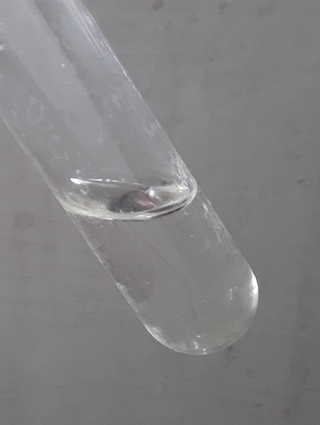
Toluene, also known as toluol, is a substituted aromatic hydrocarbon with the chemical formula C6H5CH3, often abbreviated as PhCH3, where Ph stands for phenyl group. It is a colorless, water-insoluble liquid with the odor associated with paint thinners. It is a mono-substituted benzene derivative, consisting of a methyl group (CH3) attached to a phenyl group by a single bond. As such, its systematic IUPAC name is methylbenzene. Toluene is predominantly used as an industrial feedstock and a solvent.

Tartaric acid is a white, crystalline organic acid that occurs naturally in many fruits, most notably in grapes, but also in tamarinds, bananas, avocados and citrus. Its salt, potassium bitartrate, commonly known as cream of tartar, develops naturally in the process of fermentation. It is commonly mixed with sodium bicarbonate and is sold as baking powder used as a leavening agent in food preparation. The acid itself is added to foods as an antioxidant E334 and to impart its distinctive sour taste. Naturally occurring tartaric acid is a useful raw material in organic chemical synthesis. Tartaric acid, an alpha-hydroxy-carboxylic acid, is diprotic and aldaric in acid characteristics, and is a dihydroxyl derivative of succinic acid.

Ethylene glycol is an organic compound with the formula (CH2OH)2. It is mainly used for two purposes, as a raw material in the manufacture of polyester fibers and for antifreeze formulations. It is an odorless, colorless, flammable, viscous liquid. It has a sweet taste, but is toxic in high concentrations. This molecule has been observed in outer space.

Jean Joseph Mounier was a French politician and judge.
An antifreeze is an additive which lowers the freezing point of a water-based liquid. An antifreeze mixture is used to achieve freezing-point depression for cold environments. Common antifreezes also increase the boiling point of the liquid, allowing higher coolant temperature. However, all common antifreeze additives also have lower heat capacities than water, and do reduce water's ability to act as a coolant when added to it.
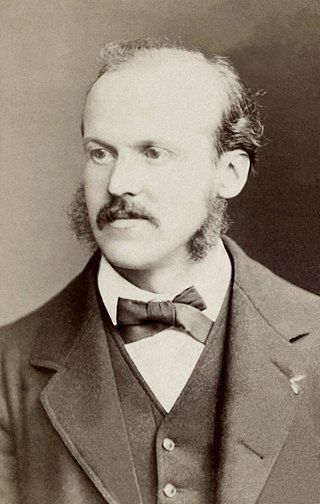
Alphonse Milne-Edwards was a French mammalogist, ornithologist, and carcinologist. He was English in origin, the son of Henri Milne-Edwards and grandson of Bryan Edwards, a Jamaican planter who settled at Bruges.
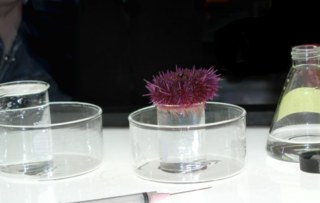
Aquatic toxicology is the study of the effects of manufactured chemicals and other anthropogenic and natural materials and activities on aquatic organisms at various levels of organization, from subcellular through individual organisms to communities and ecosystems. Aquatic toxicology is a multidisciplinary field which integrates toxicology, aquatic ecology and aquatic chemistry.

Biofouling or biological fouling is the accumulation of microorganisms, plants, algae, or small animals where it is not wanted on surfaces such as ship and submarine hulls, devices such as water inlets, pipework, grates, ponds, and rivers that cause degradation to the primary purpose of that item. Such accumulation is referred to as epibiosis when the host surface is another organism and the relationship is not parasitic. Since biofouling can occur almost anywhere water is present, biofouling poses risks to a wide variety of objects such as boat hulls and equipment, medical devices and membranes, as well as to entire industries, such as paper manufacturing, food processing, underwater construction, and desalination plants.

Théodore (Nicolas) Gobley (French:[ɡɔblɛ]; 11 May 1811, in Paris – 1 September 1876, in Bagnères-de-Luchon, was the first to isolate and ultimately determine the chemical structure of lecithin, the first identified and characterized member of the phospholipids class. He was also a pioneer researcher in the study and analysis of the chemical components of brain tissues.

Nestor Léon Marchand was a French medical doctor, pharmacist, and botanist. He is known for his studies of the flowering plant family Anacardiaceae.
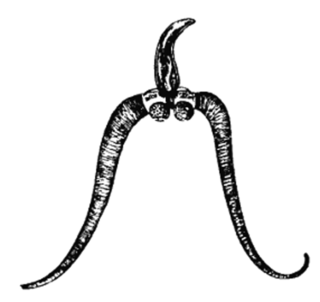
Bucephalus polymorphus is a type of flatworm. This species is within the Bucephalidae family of Digenea, which in turn is a subclass of Trematodes within the phylum Platyhelminthes. It is characterized by having a mouth near the middle of its body, along with a sac-like gut. The mouth opening is located in the centre of the ventral surface. This is a specific body type of cecaria known as a gastrostome.

Jean Paul Louis Pelseneer was a Belgian malacologist, morphologist, ethologist and phylogenist.
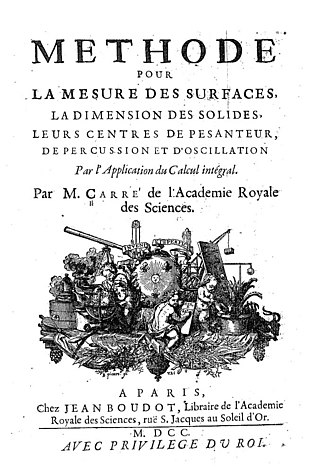
Louis Carré was a French mathematician and member of the French Academy of Sciences. He was the author of one of the first books on integral calculus.
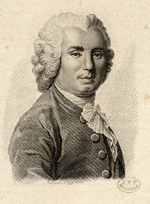
Théophile de Bordeu was a French physician.
Ultrasonic antifouling is a technology that uses high frequency sound (ultrasound) to prevent or reduce biofouling on underwater structures, surfaces, and medium. Ultrasound is just high frequency sound. Ultrasound has the same physical properties as human-audible sound. The method has two primary forms: sub-cavitation intensity and cavitation intensity. Sub-cavitation methods create high frequency vibrations, whilst cavitation methods cause more destructive microscopic pressure changes. Both methods inhibit or prevent biofouling by algae and other single-celled organisms.

Nestor Louis François Gréhant was a French physiologist.
Rosa Galvez is a Canadian Senator from Quebec. At the time of her appointment, she was a professor at Laval University and head of the university's Department of Civil Engineering and Water Engineering. Her appointment to the Senate was announced on November 2, 2016.
Jean Poirier was a French researcher, ethnologist, sociologist, and lawyer. He was a Doctor of Letters and Doctor of Law, member of the Society of Oceanists within the Musée de l'Homme, member of the Academy of Overseas Sciences, Director of the Department of Human Sciences of the University of Madagascar from 1961 to 1969 and professor at the Faculty of Letters of Nice from 1969 to his death.
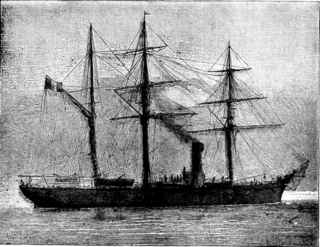
Le Talisman was a French Navy sloop built at Le Havre in 1862 which was used for geological, biological and hydrological exploration in the Atlantic Ocean and Mediterranean Sea at the end of the 19th century. It first served as a communications vessel ("aviso"), and was both sail and propeller driven.
1. Allonier, A.S., et Khalanski, M., 1996. Biodégradation du Mexel 432 par des bactéries de la Seine. Département Environnement, Groupe Gestion de l'Eau et Environnement, Electricité de France, Direction des Etudes et Recherches, Rapport n° HE-31/96-020, 17 pp.
2. Arehmouch, L., Ghillebaert, F., Chaillou, C., et Roubaud, P., 1999. Lethal effects of Mexel 432, an antifouling agent, on embryolarval development of common carp(Cyprinus carpio L.). Ecotoxicol. Environ. Safety, 42 : 110-118.
3. Czembor, N., Giamberini, L., and Pihan, J.C., 1997. Effects of Mexel 432 on pumping and valve activities of zebra mussel: used of a new experimental evaluation system. 7th International Zebra mussel conference, New-Orleans, 28- 31 Jan, 13 pp.
4. Breton, G., et Vincent, T., 2002. La plongée subaquatique permet-elle d'évaluer de manière fiable la biodiversité de l'épibenthos dans un port ? Bull. Soc. Zool. Fr., 127(2): 83-94.
5. Ghillebaert, F., 1998. Dosage colorimétrique du produit Mexel 432/0 dans les eaux du Port du Havre, rapport ecotox, 20 pp.
6. Haddouk, H., 2001. 27346 - Bacterial reverse mutation test. Centre International de Toxicologie. 36 pp.
7. Institut Pasteur de Lille, 2003. Recherche d'aberrations chromosomiques par analyse de métaphases sur lymphocytes humains en culture sur le produit Mexel 432/0, IPL-R030108 / Mexel 432/0 / EDF Recherche et Développement. 59 pp.















